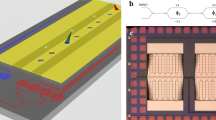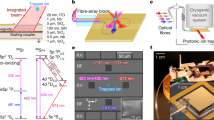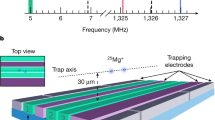Abstract
Practical and useful quantum information processing requires substantial improvements with respect to current systems, both in the error rates of basic operations and in scale. The fundamental qualities of individual trapped-ion1 qubits are promising for long-term systems2, but the optics involved in their precise control are a barrier to scaling3. Planar-fabricated optics integrated within ion-trap devices can make such systems simultaneously more robust and parallelizable, as suggested by previous work with single ions4. Here we use scalable optics co-fabricated with a surface-electrode ion trap to achieve high-fidelity multi-ion quantum logic gates, which are often the limiting elements in building up the precise, large-scale entanglement that is essential to quantum computation. Light is efficiently delivered to a trap chip in a cryogenic environment via direct fibre coupling on multiple channels, eliminating the need for beam alignment into vacuum systems and cryostats and lending robustness to vibrations and beam-pointing drifts. This allows us to perform ground-state laser cooling of ion motion and to implement gates generating two-ion entangled states with fidelities greater than 99.3(2) per cent. This work demonstrates hardware that reduces noise and drifts in sensitive quantum logic, and simultaneously offers a route to practical parallelization for high-fidelity quantum processors5. Similar devices may also find applications in atom- and ion-based quantum sensing and timekeeping6.
This is a preview of subscription content, access via your institution
Access options
Access Nature and 54 other Nature Portfolio journals
Get Nature+, our best-value online-access subscription
$29.99 / 30 days
cancel any time
Subscribe to this journal
Receive 51 print issues and online access
$199.00 per year
only $3.90 per issue
Buy this article
- Purchase on Springer Link
- Instant access to full article PDF
Prices may be subject to local taxes which are calculated during checkout




Similar content being viewed by others
Data availability
The raw data generated during this study are available from the corresponding author on reasonable request.
Code availability
The analysis code employed in this study is available from the corresponding author on reasonable request.
Change history
10 December 2020
This Article was amended to remove a minor typographical error in the main text
19 January 2021
A Correction to this paper has been published: https://doi.org/ 10.1038/s41586-020-03097-4
References
Leibfried, D., Blatt, R., Monroe, C. & Wineland, D. Quantum dynamics of single trapped ions. Rev. Mod. Phys. 75, 281–324 (2003).
Häffner, H., Roos, C. F. & Blatt, R. Quantum computing with trapped ions. Phys. Rep. 469, 155–203 (2008).
Monroe, C. & Kim, J. Scaling the ion trap quantum processor. Science 339, 1164–1169 (2013).
Mehta, K. K. et al. Integrated optical addressing of an ion qubit. Nat. Nanotechnol. 11, 1066–1070 (2016).
Kielpinski, D., Monroe, C. & Wineland, D. J. Architecture for a large-scale ion-trap quantum computer. Nature 417, 709–711 (2002).
Keller, J. et al. Controlling systematic frequency uncertainties at the 10−19 level in linear Coulomb crystals. Phys. Rev. A 99, 013405 (2019).
Harty, T. et al. High-fidelity preparation, gates, memory, and readout of a trapped-ion quantum bit. Phys. Rev. Lett. 113, 220501 (2014).
Ballance, C., Harty, T., Linke, N., Sepiol, M. & Lucas, D. High-fidelity quantum logic gates using trapped-ion hyperfine qubits. Phys. Rev. Lett. 117, 060504 (2016).
Gaebler, J. P. et al. High-fidelity universal gate set for 9Be+ ion qubits. Phys. Rev. Lett. 117, 060505 (2016).
Fowler, A. G., Whiteside, A. C. & Hollenberg, L. C. Towards practical classical processing for the surface code. Phys. Rev. Lett. 108, 180501 (2012).
Amini, J. M. et al. Toward scalable ion traps for quantum information processing. New J. Phys. 12, 033031 (2010).
Mehta, K. K., Zhang, C., Miller, S. & Home, J. P. Towards fast and scalable trapped-ion quantum logic with integrated photonics. Proc. SPIE 10933, 109330B (2019).
Wörhoff, K., Heideman, R. G., Leinse, A. & Hoekman, M. TriPleX: a versatile dielectric photonic platform. Adv. Opt. Technol. 4, 189–207 (2015).
Chiaverini, J. et al. Surface-electrode architecture for ion-trap quantum information processing. Quantum Inf. Comput. 5, 419–439 (2005).
Mehta, K. et al. Ion traps fabricated in a CMOS foundry. Appl. Phys. Lett. 105, 044103 (2014).
Schindler, P. et al. A quantum information processor with trapped ions. New J. Phys. 15, 123012 (2013).
Mehta, K. K. & Ram, R. J. Precise and diffraction-limited waveguide-to-free-space focusing gratings. Sci. Rep. 7, 2019 (2017).
Roos, C. et al. Experimental demonstration of ground state laser cooling with electromagnetically induced transparency. Phys. Rev. Lett. 85, 5547–5550 (2000).
James, D. F. Quantum dynamics of cold trapped ions with application to quantum computation. Appl. Phys. B 66, 181–190 (1998).
Wineland, D. J. et al. Experimental issues in coherent quantum-state manipulation of trapped atomic ions. J. Res. Natl Inst. Stand. Technol. 103, 259–328 (1998).
Brownnutt, M., Kumph, M., Rabl, P. & Blatt, R. Ion-trap measurements of electric-field noise near surfaces. Rev. Mod. Phys. 87, 1419–1482 (2015).
Sørensen, A. & Mølmer, K. Entanglement and quantum computation with ions in thermal motion. Phys. Rev. A 62, 022311 (2000).
Leibfried, D. et al. Experimental demonstration of a robust, high-fidelity geometric two ion-qubit phase gate. Nature 422, 412–415 (2003).
Sedlacek, J. et al. Distance scaling of electric-field noise in a surface-electrode ion trap. Phys. Rev. A 97, 020302 (2018).
Milne, A. R. et al. Phase-modulated entangling gates robust to static and time-varying errors. Phys. Rev. Appl. 13, 024022 (2020).
Srinivas, R. et al. Trapped-ion spin-motion coupling with microwaves and a near-motional oscillating magnetic field gradient. Phys. Rev. Lett. 122, 163201 (2019).
Harty, T. et al. High-fidelity trapped-ion quantum logic using near-field microwaves. Phys. Rev. Lett. 117, 140501 (2016).
Zarantonello, G. et al. Robust and resource-efficient microwave near-field entangling 9Be+ gate. Phys. Rev. Lett. 123, 260503 (2019).
Debnath, S. et al. Demonstration of a small programmable quantum computer with atomic qubits. Nature 536, 63–66 (2016).
Lindenfelser, F., Marinelli, M., Negnevitsky, V., Ragg, S. & Home, J. P. Cooling atomic ions with visible and infra-red light. New J. Phys. 19, 063041 (2017).
West, G. N. et al. Low-loss integrated photonics for the blue and ultraviolet regime. APL Photon. 4, 026101 (2019).
Niffenegger, R. J. et al. Integrated multi-wavelength control of an ion qubit. Nature https://www.nature.com/articles/s41586-020-2811-x (2020).
Kaufmann, H. et al. Scalable creation of long-lived multipartite entanglement. Phys. Rev. Lett. 119, 150503 (2017).
Schäfer, V. et al. Fast quantum logic gates with trapped-ion qubits. Nature 555, 75–78 (2018).
Saffman, M., Walker, T. G. & Mølmer, K. Quantum information with Rydberg atoms. Rev. Mod. Phys. 82, 2313–2363 (2010).
McKenna, T. P. et al. Cryogenic packaging of an optomechanical crystal. Opt. Express 27, 28782–28791 (2019).
Elshaari, A. W., Zadeh, I. E., Jöns, K. D. & Zwiller, V. Thermo-optic characterization of silicon nitride resonators for cryogenic photonic circuits. IEEE Photon. J. 8, 2701009 (2016).
Leupold, F. M. Bang-bang Control of a Trapped-Ion Oscillator. PhD thesis, ETH Zurich (2015).
Lucas, D. et al. Isotope-selective photoionization for calcium ion trapping. Phys. Rev. A 69, 012711 (2004).
Allcock, D. et al. Implementation of a symmetric surface-electrode ion trap with field compensation using a modulated Raman effect. New J. Phys. 12, 053026 (2010).
Ballance, C. J. High-fidelity Quantum Logic in Ca +. PhD thesis, Oxford Univ. (2017).
Kotler, S., Akerman, N., Glickman, Y. & Ozeri, R. Nonlinear single-spin spectrum analyzer. Phys. Rev. Lett. 110, 110503 (2013).
Roos, C. et al. Nonlinear coupling of continuous variables at the single quantum level. Phys. Rev. A 77, 040302 (2008).
Nie, X. R., Roos, C. F. & James, D. F. Theory of cross phase modulation for the vibrational modes of trapped ions. Phys. Lett. A 373, 422–425 (2009).
Ma, L.-S., Jungner, P., Ye, J. & Hall, J. L. Delivering the same optical frequency at two places: accurate cancellation of phase noise introduced by an optical fiber or other time-varying path. Opt. Lett. 19, 1777–1779 (1994).
Lechner, R. et al. Electromagnetically-induced-transparency ground-state cooling of long ion strings. Phys. Rev. A 93, 053401 (2016).
Acknowledgements
We thank D. Marchenko, D. Geuzebroek and A. Leinse at LioniX International for fabrication of the devices and for discussions during design; V. Negnevitsky and Matteo Marinelli for their work on the experimental control system and software used for these experiments; S. Miller for assistance in characterization of fabricated photonic devices; F. Gürkaynak at ETH for support with CAD software; the ETH FIRST cleanroom staff; and E. Schlatter for helpful advice on epoxies. We acknowledge funding from the Swiss National Fund grant number 200020165555, NCCR QSIT, ETH Zürich, the EU Quantum Flagship, and an ETH Postdoctoral Fellowship.
Author information
Authors and Affiliations
Contributions
K.K.M. conceived the work, and designed, characterized and assembled the trap devices. K.K.M., C.Z. and M.M. performed the trapped-ion experiments in an apparatus with substantial contributions from C.Z., M.M., T.-L.N. and M.S. KKM analysed the data. J.P.H. supervised the work, and K.K.M. wrote the manuscript with input from all authors.
Corresponding author
Ethics declarations
Competing interests
The authors declare no competing interests.
Additional information
Peer review information Nature thanks Jungsang Kim and the other, anonymous, reviewer(s) for their contribution to the peer review of this work.
Publisher’s note Springer Nature remains neutral with regard to jurisdictional claims in published maps and institutional affiliations.
Extended data figures and tables
Extended Data Fig. 1 Design layout.
a, Mask images for device fabrication across a four-inch wafer. b, Individual 2.2 × 2.2 cm2 reticle, showing trap designs as well as independent optics test structures. c, Trap design used in ion experiments presented here. In all images, SiN features are shown in red, the top trap electrode layer in grey and the ground plane in blue. The eight waveguides coupled to the fibre array are labelled at the left, with inputs 1 and 8 forming a loop structure used to align the fibre V-groove array.
Extended Data Fig. 2 Fibre attachment.
Fibre attachment process schematic and measured single-pass fibre–waveguide coupling losses inferred from a loop-back structure on-chip; solid line is a guide to the eye.
Extended Data Fig. 3 Ramsey coherence measurements.
We apply two π/2 pulses separated by a variable wait time, and the fringe contrast on scanning the phase of the second pulse relative to the first is plotted to assess \({T}_{2}^{\ast }\). Data are shown using the same light guided through the in-cryostat fibres and integrated couplers (black points and fit) or through free space (red points and fit). The fit to the data observed with the integrated coupler was used to infer laser noise parameters relevant to gate infidelity calculation; the observation of markedly faster decoherence when driving with the free-space beam (red points/fit) using the same 729-nm source indicates the integrated beam path’s advantage in insensitivity to cryostat vibrations. Error bars on points represent 68% confidence intervals on fit contrasts.
Extended Data Fig. 4 Readout histograms.
Histogram of photomultiplier tube (PMT) counts observed in detection events over all points in the parity scan of Fig. 4, fitted to a sum of three Poissonian distributions. Each distribution corresponds to counts obtained during a 250-μs detection period from events with either 0, 1 or 2 ions in the bright state.
Extended Data Fig. 5 Cross-talk characterization.
a, b, Rabi oscillations at zone 3 with light coupled to the port directly addressing this zone (input 3) (a), and with light coupled to the port intended to address zone 2 (input 5) (b). Fits to Rabi oscillations with a Gaussian envelope decay indicate π-times of 2.4 μs (a) and 2.6 ms (b).
Rights and permissions
About this article
Cite this article
Mehta, K.K., Zhang, C., Malinowski, M. et al. Integrated optical multi-ion quantum logic. Nature 586, 533–537 (2020). https://doi.org/10.1038/s41586-020-2823-6
Received:
Accepted:
Published:
Issue Date:
DOI: https://doi.org/10.1038/s41586-020-2823-6
This article is cited by
-
Penning micro-trap for quantum computing
Nature (2024)
-
Room-temperature waveguide-coupled silicon single-photon avalanche diodes
npj Nanophotonics (2024)
-
A chip-scale second-harmonic source via self-injection-locked all-optical poling
Light: Science & Applications (2023)
-
Widely tunable and narrow-linewidth chip-scale lasers from near-ultraviolet to near-infrared wavelengths
Nature Photonics (2023)
-
A sub-wavelength Si LED integrated in a CMOS platform
Nature Communications (2023)
Comments
By submitting a comment you agree to abide by our Terms and Community Guidelines. If you find something abusive or that does not comply with our terms or guidelines please flag it as inappropriate.



